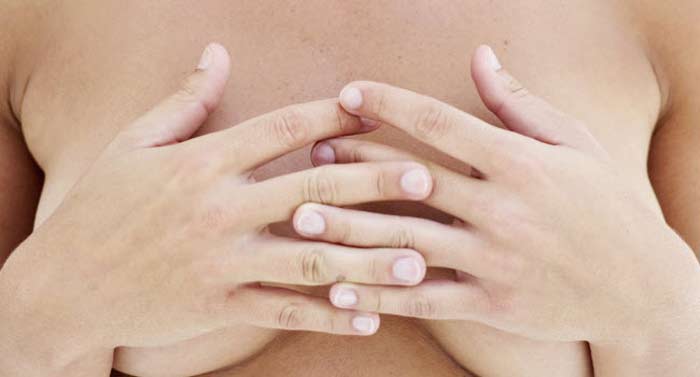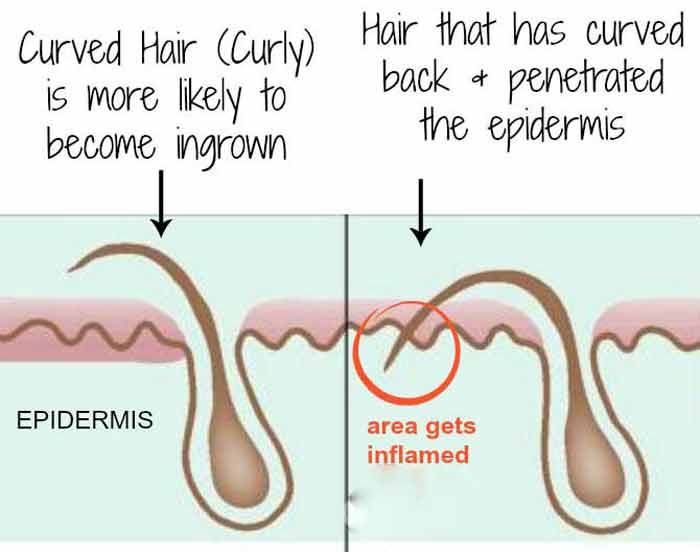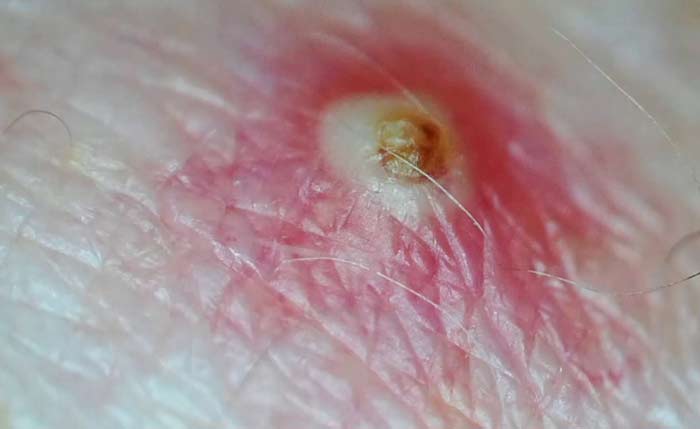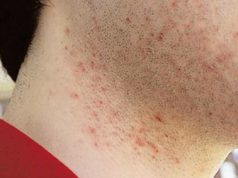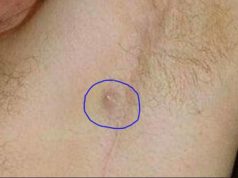Tiny chest hairs might not strike most women to the extent of being uncomfortable and unsightly. To others, this hair is annoying and they would be dying to get rid of them. The latter might be too indulged in the annoyance they cause forcing them to get them shaved. Well, this might not be the best idea of all as shaving hair has an implication of causing ingrown hairs.
Ingrown hairs are known to hurt when they occur and this can be irritating to the skin. They cause your breast to itch and as you might notice, it isn’t the sharpest idea to scratch your breast; especially in public.
Symptoms & Causes Female
On the breast around the teat ingrown hairs occur in the same manner as that in other parts of the body. The hair shaft upon shaving against the grain may curve and curl on itself. This makes it grow inwards rather than growing upwards and outwards.
It causes inflammation as it forces its way through the dermis disrupting the integrity of dermal cells in the long run resulting in a bump of bumps with dark spots in the middle. Ingrown hairs on the chest appear on the teats.
Tendency of occurrence of ingrown hairs in females is higher during puberty due to the hormonal fluctuations that start in that period. This is due to the embarrassment that adolescents associate it with.
According to studies, chest hair occurs in close to 25% of women. They may also appear later in life again due to hormonal changes.
Pictures under Breast, on & in Breasts
Causes
Hair growth in excess
Ladies are moreso affected by excessive hair growth in a condition known as hirsuitism. This condition results in the production on hair on the chest, upper lips and on the back and shoulders. This is hair that occurs in men due to dominance of testosterone.
Hirsuitism is most commonly caused by medication such as phenytoin (anti-seizure) and danazol. Women who also have an extra sensitivity to testosterone will observe extra hair.
Diseases such as Polycystic Ovarian Syndrome (PCOS), leads to hormonal imbalance and may lead to this condition. Generally, hirsuitism may lead to ingrown hair as the probability is increased to getting the same.
Wearing a tight bra or blouse
For hair shafts to bend inwards and result in ingrown hair, there needs to be pressure exerted on them. Women wearing tight and smaller bras than can fit them yet have breast hair face a risk of getting these lumps of ingrown hair. Friction is also tighter and going against the grain, may cause it.
Plucking, waxing and shaving
Plucking breast hair can be really dangerous as in most cases, the follicle breaks from the inside of the skin. It is one major cause of ingrown hairs.
Waxing methods pluck hair from their roots making the pores hairless for a particular period of time. However, this method can still make the shafts break from the inside. Waxing may disrupt the lining along which hair grows making it stick in side and curl on itself.
Not exfoliating after hair removal procedures
whether you choose to pluck or wax off your breast hair, you need to take enough time to remove the dead cells and hair follicles that remain in the pores.
This removes the dead skin cells that have clogged the path of hair growth from its roots. Not doing this causes hairs to grow inwards.
Shaving against the grain and using the blunt razor
Take your time to discover the direction of hair growth on your breast. Shaving the chest region can be a bit tricky and doing it too close to the skin surface and again using a blunt razor will only make the hair curve.
Conditions and illnesses
Some of these increase the probability of getting ingrown hairs. One of these conditions is Cushing’s syndrome. In this condition, there is a high exposure to cortisol same to what medications called glucocorticoids (prednisone) do.
Symptoms
Typical symptoms of ingrown hairs include:
- Small bumps or lumps – ingrown hairs on the breasts cause lumps to form. This is due to inflammation that occurs in response to the hair growing into the dermis.
- Tenderness – refers to pain on touching. The area when touched exerts pressure on the swelling causing more pain.
- Tingling sensations – as a response to pain, itching is physiologically imposed to deter transmission of signals through the nerves.
- Constant pain – when it is an infection, the lump becomes continuously in pain even without touching it.
- Formation of pustules – complication into an infection results in the formation of pus which fills the cavity formed. It might as well have graduated into an ingrown hair cyst on the breast at this stage.
- Scarring – this occurs during the healing process. Deposition of keratin occurs and it becomes dark and hard to touch.
Ingrown Hair Chest Hair Male
Causes & Symptoms
Ingrown hairs on the breast can also occur in males. Wait, men too have breasts if you hadn’t known that. They might not be as big to notice as in females but ingrown hairs do not choose.
Here are some of the causes and symptoms of ingrown hairs in males.
- Coarse or curly hair on the chest – anyone is able to get ingrown hair on the breast. It is however more prone to occur in men with curly hair that can stick its tip through the skin.
- Oily skin and excessive sebum – excessive sebum on the chest of men may lead to clogging up of the pores through which hair grows. Hampering its exit makes it curl back and in grow.
- Wearing too tight a cloth such as a vests or t-shirts – as mentioned earlier in females, males are also not segregated when it comes to wearing tight clothes. Tight clothing on the breast area forces hair follicles to grow inwards.
- Not taking care of your skin – most males do not take care of their skin as they should. They may assume moisturizing the skin allowing the skin to dry up and even form cracks. This is dangerous especially if you have thick hair growth on your breast area. The dry skin is easier to penetrate.
- Shaving inappropriately – men tend to shave their chest hair if in excess. Some may not. Among those who shave, if poorly done such as shaving against the direction of hair growth or using the wrong or poor quality tools, getting ingrown hairs is easy.
Ingrown hairs in males results in larger lumps. They are itchy, tender and painful when infected. If the inflammation is filled with pus, it bears a white head.
How to remove Ingrown Hair
Whether male or females you could benefit from the following ways to rid of ingrown hairs.
- Exfoliate – you could use a scrub to get rid of dirt and dead skin accumulated and leading to the ingrown hair. Exfoliating also helps nudge out the hair by adjusting the tip along the growth path. You can also make a homemade scrub using salt or sugar. Measure out 2 teaspoonfuls of either and mix with an essential oil such as tea tree oil or olive oil. Then apply and rub on the affected area.
- Tweezing – to nip the ingrown hair out, use sterilized tweezers. Apply some exfoliating cream first, pat dry with a clean towel, then apply some alcohol to the area. Make sure that the tip or shaft of the hair is visible then tag it out. If the area is hard and fluid filled, place a washcloth dipped in hot water on the area to rid the fluid then use the tweezers. Do not dig into the lump looking for the hair follicle if you cannot see it. Once you have the hair out, using a nail scissors, trim the curl.
- Warm compress – clean a gauze then soak in warm water for about 5 minutes. Clean the area affected then place the gauze on the area. The purpose of this is to flatten the lump and make the hair embedded visible.
- Moisturize – using a simple moisturizing lotion could do you great good if you have no confidence to tweeze. Moisturize your skin when dry. It should help with easing the inflammation and itching. Do this in generous measures.
- Allowing the hair grow – if you cannot tweeze out the hair, then do not dig looking for it. Either use warm compress or exfoliate then let it grow by itself. Keep checking until it is sufficient to pull out.
Further Reading:
Infected Ingrown Hair
To know that your ingrown hair is infected, it is red or white depending on the extent of infection. It is foul smelling when drained. It is generally what you would call an ingrown hair boil.
If it is infected, the following will either be prescribed for you. You could also make some at home to relieve the pain and inflammation.
- Anti-inflammatories – acetaminophen, ibuprofen or aspirin are indicated to reduce the redness, pain and swelling. Salicylic acid prescribed as an acne medication may also be used to ease the inflammation.
- Antibiotics – antibiotics are best prescribed when the area has been drained of its fluid. This is because of the tendency of some antibiotics to penetrate the abscess. Some antibiotics that will be prescribed include amoxicillin, erythromycin or fusidic acid. Fusidic acid and erythromycin are mostly delivered topically.
- Vinegar soak – this is considered as a fast fix treatment for ingrown hair on the breast. To use it, soak a gauze in vinegar then apply on the affected sport on the breast. It will help bring the hair to the surface. To make this, mix one part of vinegar and an equal part of water to prepare the soak solution.
Prevention Tips & Ideas
- Simply leave the hair on your chest to grow freely without attempting to shave it.
- If you must remove the hair and wouldn’t want to shave, then use alternative methods such as depilatory creams.
If you must shave, then;
- Use sharp tools such as a razor
- Use a single bladed tool
- Don’t shave too close to the skin surface
- Don’t shave against the grain
- To prevent infections, use a clean razor sterilized and do not reuse disposable razors

